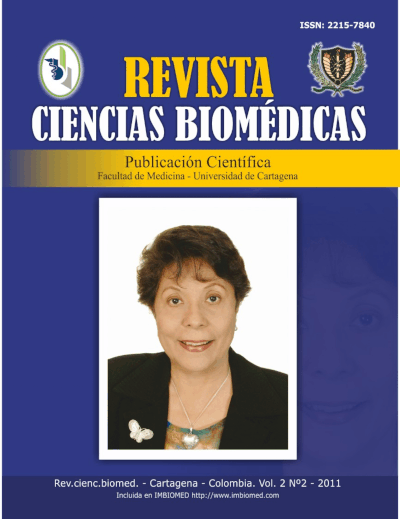Resultados perinatales y terapia tocolítica durante trabajo de parto en pretérminos tardíos. clinica de maternidad Rafael calvo. Cartagena. noviembre 2009 – junio 2010
Resultados perinatales y terapia tocolítica durante trabajo de parto en pretérminos tardíos. clinica de maternidad Rafael calvo. Cartagena. noviembre 2009 – junio 2010
Contenido principal del artículo
Resumen
Introducción: en los últimos años se han incrementado las tasas de nacimientos pretérminos. Dos tercios son infantes pretérminos tardíos. Se han descrito diferentes determinantes de su morbilidad y mortalidad neonatal, pero es desconocido el efecto que sobre estas puede tener el uso de tocolíticos al intentar retrasar el parto cuando el feto podría encontrarse en un medioambiente potencialmente hostil.
Objetivo: describir las diferencias en los resultados perinatales cuando se utilizan o no tocolíticos durante el trabajo de parto en pretérminos tardíos.
Métodos: estudio descriptivo retrospectivo. Se analizaron expedientes clínicos de gestantes en trabajo de parto en el periodo pretérmino tardío entre noviembre de 2009 y junio de 2010 en la E.S.E Clínica Maternidad Rafael Calvo. Se compararon variables sociodemográficas, clínicas, resultados neonatales entre los grupos con el uso o no de tocolíticos.
Resultados: de 196 pacientes, 67 fueron seleccionadas, 31(46,2%) recibieron tocolíticos y 36(53,7%) no. La media de edad y de la edad gestacional fueron de 22,3(DE= 5.9) años y 35,4(DE= 0,72) semanas, respectivamente. Al comparar los grupos (tocólisis o no), hubo diferencia significativa en el intervalo diagnóstico–parto (<0,0001). El 61.2% tuvieron parto por vía vaginal. El 52.2% fueron de sexo femenino, una media de peso al nacer de 2714 ± 342.8 gramos y de talla de 47.6 ± 2 cms. El APGAR al minuto fue significativamente mucho menor (entre 3 y 7) en el grupo con tocólisis (p=0.0342).
Conclusiones: el uso de tocolíticos durante el trabajo de parto en pretérminos tardíos podría tener un efecto negativo sobre la respuesta adaptativa al nacer. Rev.cienc. biomed. 2011; 2 (2): 226-232
Palabras clave
Descargas
Datos de publicación
Perfil evaluadores/as N/D
Declaraciones de autoría
- Sociedad académica
- Universidad de Cartagena
- Editorial
- Universidad de Cartagena
Detalles del artículo
Referencias (VER)
Lumley J. Defining the problem: the epidemiology of preterm birth. Br J Obstet Gynaecol 2003; 110 (Suppl 20), pp. 3–7.
Davidoff MJ, Dias T, Damus K, Russell R, Bettegowda VR, Dolan S, et al. Changes in the gestational age distribution among U.S. singleton births: Impact on rates of late preterm birth, 1992 to 2002. Semin Perinatol 2006; 30:8-15.
Raju T, Higgins R, Stark A and Leveno K. Optimizing Care and Outcome for Late-Preterm (Near-Term) Infants: A Summary of the Workshop Sponsored by the National Institute of Child Health and Human Development. Pediatrics 2006; 118: 1207-14
McIntire D and Leveno K. Neonatal Mortality and Morbidity Rates in Late Preterm Births Compared With Births at Term. Obstet Gynecol 2008; 111:35–41.
Late-preterm infants. ACOG Committee Opinion No. 404. American College of Obstetricians and Gynecologists. Obstet Gynecol 2008; 111:1029–32.
Goldenberg R. The Management of Preterm Labor. Obstet Gynecol 2002; 100: 1020–37.
Goldenberg RL, Culhane JF, Iams JD, Romero R. Epidemiology and causes of preterm birth. Lancet 2008; 371: 75–84
Romero R, Espinoza J, Kusanovic J, Gotsch F, Hassan S, Erez O, et al. The preterm parturition syndrome. Br J Obstet Gynaecol 2006; 113 (Suppl. 3):17–42.
Berkman N, Thorp J, Lohr K, Carey T, Hartmann K, Gavin N, et al . Tocolytic treatment for the management of preterm labor: A review of the evidence. Am J Obstet Gynecol 2003; 188:1648-58.
How H, Zafaranchi L, Stella C, Recht K, Maxwell R, Sibai B, Spinnato J. Tocolysis in women with preterm labor between 32 0/7 and 34 6/7 weeks of gestation: A randomized controlled pilot study. Am J Obstet Gynecol. 2006; 194: 976–81
Steer P. The epidemiology of preterm labour—why have advances not equated to reduced incidence? Br J Obstet Gynaecol 2006; 113(Suppl. 3):1–3
Royal College of Obstetricians and Gynaecologists. Tocolysis for Women in Preterm Labour. Green-top Guideline 1b. London: RCOG; 2011.
Shapiro-Mendoza CK, Tomashek KM, Kotelchuck M, Barfield W, Weiss J, Evans S. Risk factors for neonatal morbidity and mortality among “healthy,” late preterm newborns. Semin Perinatol 2006;
:54–60.
Cunninghan FG, Leveno KJ, Bloom SL, Haulth JC, Rouse DJ,editors. Preterm Birth. Chapter 36. In Williams Obstetrics, 23 ed. The McGraw-Hill Companies; 2010.
Management of preterm labor. ACOG Practice Bulletin. No 43, American College of Obstetricians and Gynecologists. Obstet Gynecol 2003;101:1039 – 47.
Haas DM, Imperiale TF, Kirkpatrick PR, Klein RW, Zollinger TW, Golichowski AM. Tocolytic therapy: a meta-analysis and decision analysis. Obstet Gynecol 2009; 113:585–94.
Elliott JP, Istwan NB, Rhea DJ, Desch CN, and Stanziano GJ. The Impact of Acute Tocolysis on Neonatal Outcome in Women Hospitalized with Preterm Labor at 32 to 34 Weeks’ Gestation. Am J Perinatol 2009; 26:123–128
Fox MD, Allbert JR, McCaul JF, Martin RW, McLaughlin BN, Morrison JC. Neonatal morbidity between 34 and 37 weeks’ gestation. J Perinatol 1993; 13:349-53.
Conde-Agudelo A, Romero R, Kusanovic JP. Nifedipine in the management of preterm labor: a systematic review and metaanalysis. Am J Obstet Gynecol 2011;204:134.e1-20
Catlin EA, Carpenter MW, Brann BS, et al. The Apgar score revisited: influence of gestational age. J Pediatr. 1986;109:865–868.
Wang M, Dorer D, Fleming F, and Catlin E. Clinical Outcomes of Near-Term Infants Pediatrics 2004;114:372-376.
Rebarber A, Cleary-Goldman J, Istwan N, Rhea D, Stanziano G, and Saltzman D. The Association of Elective Cessation of Tocolysis and Preterm Birth in Singleton Gestations. Am J Perinatol 2009;
:351–355.
Melamed N, Klinger G, Tenenbaum-Gavish K, Herscovic T, Linder N, Hod M, and Yogev Y. Shortterm Neonatal Outcome in Low-Risk Spontaneous, Singleton, Late Preterm Deliveries. Obstet Gynecol 2009;114:253–60.



 PDF
PDF
 FLIP
FLIP





